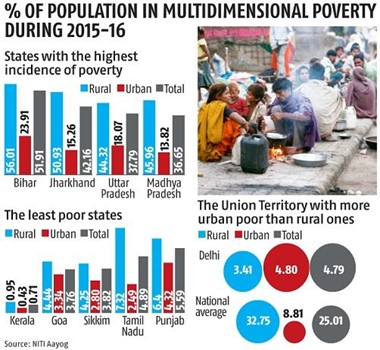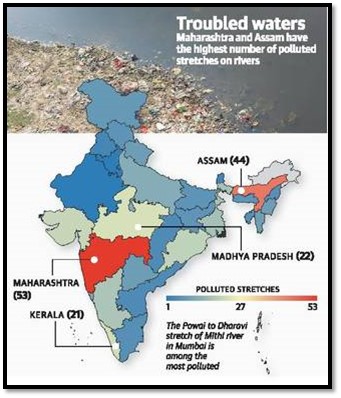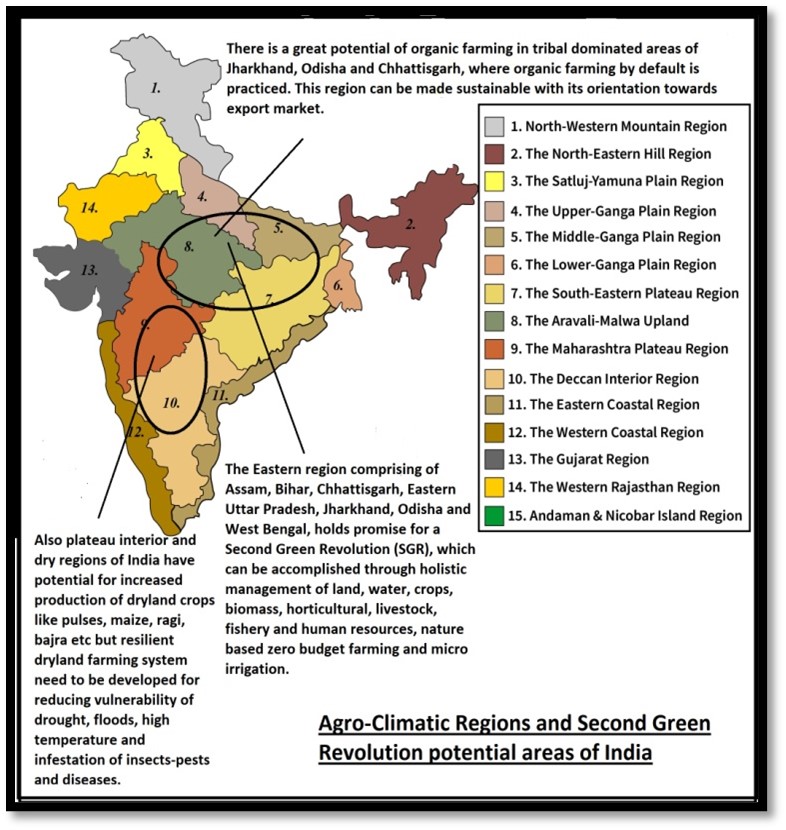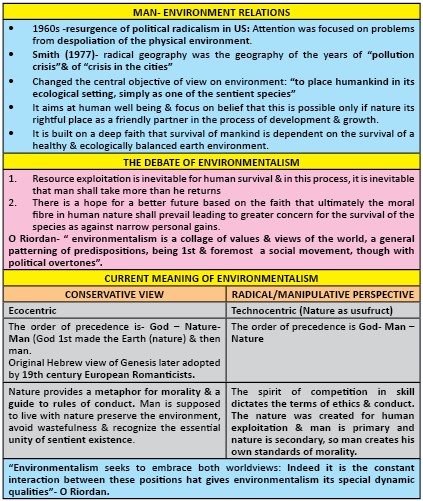15 Jan
Distribution of coal resources across world & challenges faced in coal crisis
- In News: India is the latest country to face a severe power crisis that threatens to undermine its recovery from the pandemic.
- Global distribution of coal The major areas are principally in the Northern Hemisphere; with the exception of Australia, the southern continents are relatively deficient in coal deposits. This relatively uneven distribution is the result of peat formation at different times in the geological past in predominantly tropical latitudes, and the subsequent drift of the continents to their present-day positions.
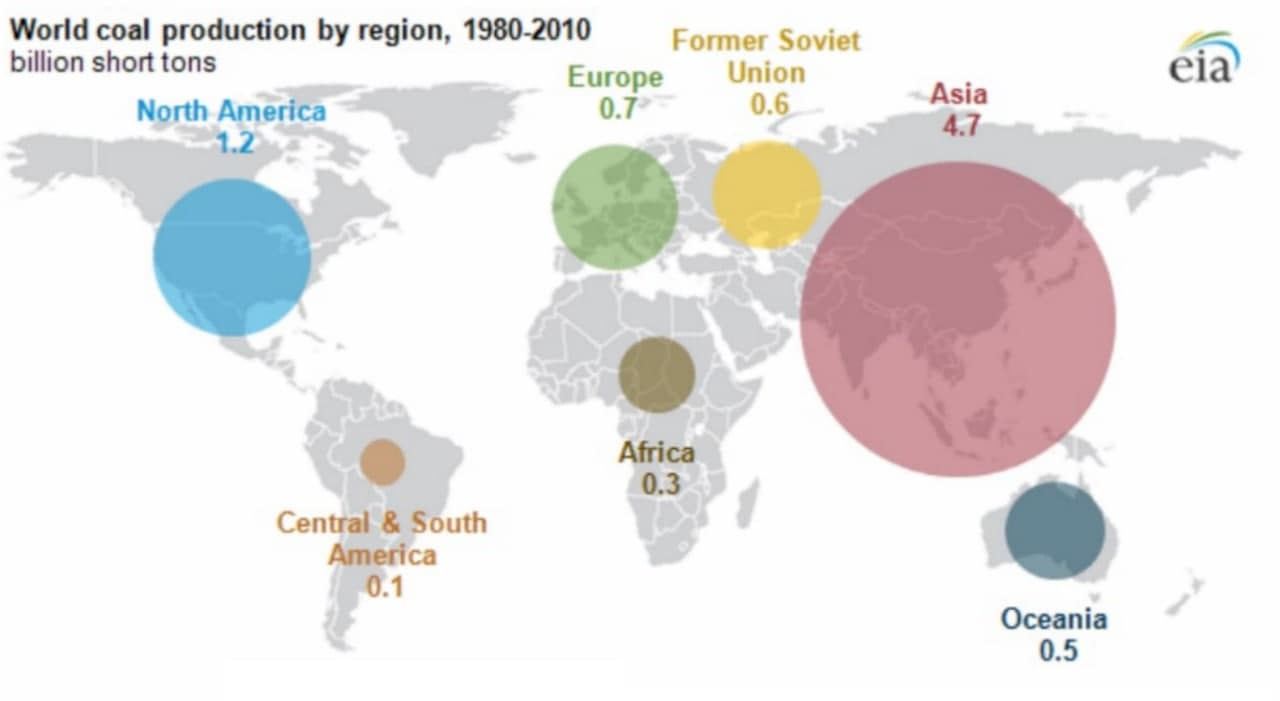
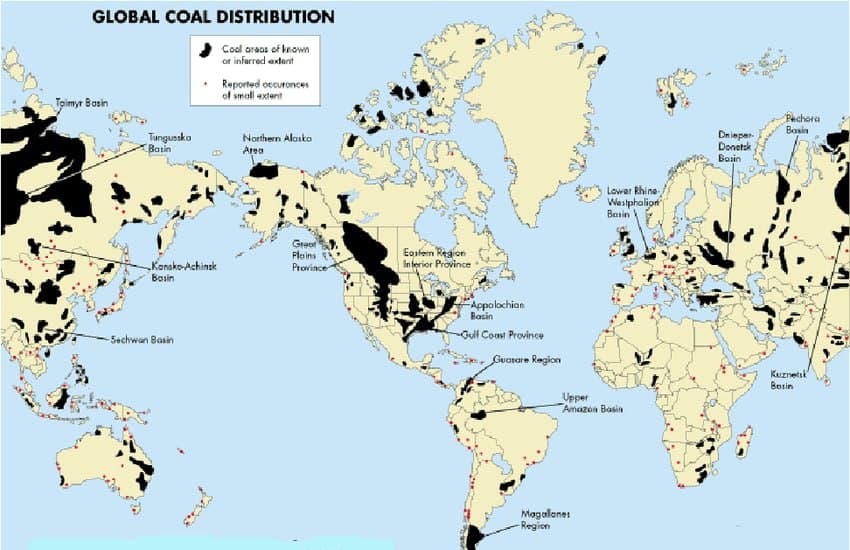
- Coal formation around world:
- The oldest coals of any economic significance date from the Middle Carboniferous Period — the earliest geological strata in which coal has been identified are of Devonian age but they are of little economic significance.
- With the exception of parts of the Triassic Period, major coal deposits have been forming somewhere in the world throughout the last 320 Ma.
- Sedimentary sequences of the last 2-3 Ma do not contain coals, simply because there has been insufficient time for them to develop from plant debris.
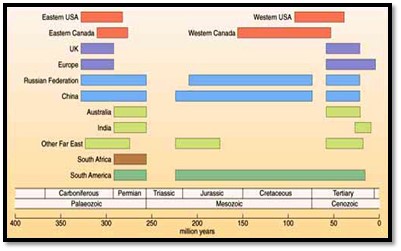
Possible future coals exist today in the form of peats that are accumulating in modern mires.
-
-
- A broad chain of large coalfields of Carboniferous age extends from the eastern USA, through Europe, the Russian Federation and south into China.
- A second chain of Permian coalfields is found in the southern continents — South America, India, southern Africa, Australia and Antarctica.
- The vast coalfields of the western USA and Canada are of Cretaceous-Tertiary age.
- Mesozoic-Cenozoic lignite are also important global sources of coal.
-
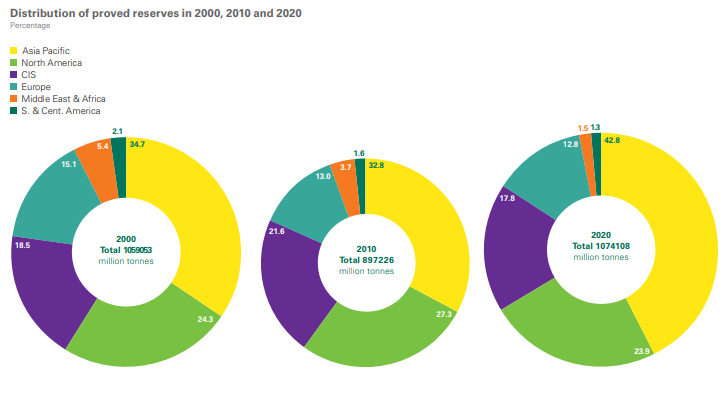
- Coal in the global energy mix: The term “energy mix” refers to the combination of the various primary energy sources used to meet energy needs in a given geographic region. Coal supplies over one-third of global electricity generation and plays a crucial role in industries such as iron and steel.
- Patterns of international (thermal) coal trade are shifting.
- Traditionally trade could be characterised by two geographic basins: the Pacific Basin, where Japan and Korea were the top importers; and the Atlantic Basin, where the European countries imported most of the traded coal. South Africa, and to a much lesser extent Russia, linked the two basins in coal trade.
- This no longer portrays international coal trade patterns, as the Atlantic market has separated from Asian market. For instance, in 2019, the volume of coal imports in India were almost double EU import quantities, a clear indicator of a shift to Asia and the waning of Europe in international coal markets. Indonesia remained the world’s largest exporter and Australia ranked second. China was the largest importer of coal in 2019 at 308 Mt, followed by India at 249 Mt.
- Coal’s importance in the Indian economy

-
- With India’s power demand expected to double in the coming decade, coal power generation may not yet have reached its peak.
- According to International Energy Agency (IEA), coal-generated power plant account for around 70 percent of India’s electricity generation. This share is estimated to remain above 50 per cent even in 2030.
- Further, India’s current installed coal capacity of 209 GW is set to expand, with around 57 GW of new capacity in the pipeline. Coal is a reliable energy source, especially when compared with the seasonal and diurnal variability of renewables.
- It is considered important for the nation's energy security and is a key source of revenue for the government. The state-owned Coal India Limited (CIL) is the largest coal miner in the world; it pays around INR 40,000 crore annually in royalties, cesses, and levies, besides rich dividend payouts to the government.
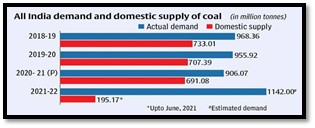

-
- Coal production also benefits the Indian Railways (IR), which cross-subsidises passenger fares with high freight rates for coal transportation.
- Coal production supports millions of lives and livelihoods – either directly or indirectly, and to varying degrees.
- Coal crises in India:
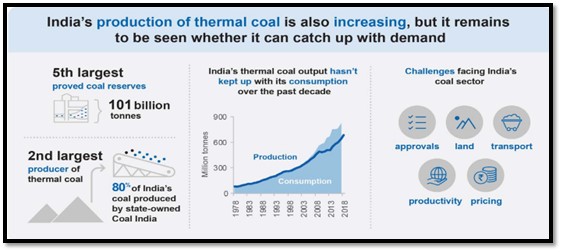
-
- India’s thermal power plants currently have an average of four days worth of coal stockagainst a recommended level of 15-30 days, with a number of states highlighting concerns about blackouts as a result of the coal shortage.
- A number of states including Delhi, Punjab and Rajasthan have raised concerns about potential blackouts as a result of low coal inventory at thermal power plants. Rajasthan, Punjaband Bihar have already reported load shedding as a result of thermal power plants operating at low capacity.
- The shortage in coal is a result of a sharp uptick in powerdemand as the economy recovered from the effects of the pandemic.
- Reasons such as excessive rainfall, international price rise, Covid-19 pandemic, less production, transportation issues including freight rates and high consumption were cited as the reason for the coal shortage.
- A sharp increase in the international prices of coal due to a shortage in China and low accumulation of stockby thermal power plants have also contributed to the coal shortage.
- Other Challenges in coal supplies in India:
- Land acquisition has been a substantial barrier to improving coal supply in India.
- Transport and infrastructure Logistics are another key constraint. The majority of India’s coal-fired generation capacity is located in the northern and western regions of the country, while coal production is concentrated in the eastern region. As such, most of India’s domestically-produced coal needs to be transported long distances, adding to costs- Inadequate rail infrastructure and the cost of transportation have been key barriers to domestic supply growth.
- Coal freight rates are also very high, due to a cross-subsidy between passenger and freight users. Freight tariffs in India are among the highest in the world on a purchasing power parity basis, while its passenger tariffs are among the lowest.
- While inadequate rail infrastructure has contributed to the increased reliance on imports, imports also face transportation challenges. Coal imports have also been affected by port congestion, particularly on the east coast, and by inadequate rail infrastructure to transport coal from ports to utilities.
- Labour productivity in India’s coal sector remains low relative to other coal producing countries as a result of the use of older technologies and production methods.
- Technology adoption in underground mining is particularly limited. Even though India is on an aggressive path to increase the proportion of renewables in its energy mix, coal still remains the backbone of the power sector. India’s dependence on coal also contributes heavily to its trade deficit. To address the current crisis and help in import substitution, the government has allowed companies with captive mines to sell 50% of their annual output in the open market. Additionally, to avoid a demand-supply mismatch, the power and coal Ministries have jointly decided to draw up a monthly coal supply programme for thermal power units.
- Where can we use it:
- Geography:
Paper 1: Economic Geography (resources and distribution), Environmental Geography.
Paper 2: Resources ,contemporary issues (regional disparities in economic development).
Source:
Multi-level planning: role of gram panchayat in India
- Background:
- The concept of multi-level regional planning may be defined as 'planning for a variety of regions which together form a system and subordinate systems'.
- In multi-level planning, the various levels of planning provide bases for higher level planning. Similarly, the higher level regional plans provide the basic framework for the lower level plans.
- In such plans, there is direct participation of the people in the planning process. In multi-level planning, every region/unit constitutes a system and hence, the planning process becomes more effective.
- Panchayats are the grassroots institution of governance. The 73rd Amendment of the Constitution in 1993, laid the foundation of the panchayats. The democratic three-tier system of local governance aims at devolution of powers, funds, and responsibilities to the panchayats, for economic, community, and social development of the villages.
- Mahatma Gandhi's vision of 'Gram Swaraj' to make villages self-reliant and decentralised is taken care of in the Panchayati Raj Institutions (PRIs). These institutions facilitate the participation of the people in the process of planning and development..

- Advantages of MLP-grass root level:
- Regional development
- Ensure integrated and inclusive development of the rural areas governed by Gram Panchayats, which is not only geared towards infrastructure oriented development but also social, economic, and community development.
- Local resource based development: They ensure identification of locally-available resources and addressing local needs of all communities through participatory planning and convergence.
- Vertical unity development: Bottom-up Planning - Multi-level Planning opposed to centralized planning is an exercise where local institutions are actively involved not only at the implementation level but MLP is a more integrative effort that seeks to involve all hierarchies of administrative, geographical, political and regional levels in planning process. It seeks to involve active participation of the lower hierarchical levels in information generation, data collection, policy suggestion, plan implementation & monitoring of all developmental activities.
- Enable and engage the community in participatory planning and decision-making processes- promoting decentralised participatory planning.
- Ensure inclusion and welfare of the Scheduled Tribes, Scheduled Castes, and other marginalized communities, Other Backward Communities, women and children, vulnerable groups, people with disabilities, etc., in the formulation and implementation of the GPDP to ensure the provision of basic social goods and a life of dignity.
- The Ministry of Panchayati Raj is striving towards strengthening PRIs and accomplishing objectives of local self-governance towards an inclusive, community-driven, and holistic planning process.
- Improve efficiency and efficacy in public service delivery in local areas.
- Strengthens accountability measures at the local level.
- Localized development of Sustainable development goals: SDG s are ambitious goals aim to end poverty, tackle inequality once and for all, and find lasting solutions to the environmental challenges faced by the world. With decentralized effort, the data revolution for Sustainable Development has gained momentum to improve the identification of the world's needs and to enhance the targeting of the resources towards development by supporting data driven decision-making, evidence-based policies, and mutual accountability by the government at various levels and other stakeholders.
- Regional development
Case study: Ibrahimpur, Telangana
- Ibrahimpur village in Narayanaraopet Block in Siddipet district has been getting attention recently owing to the Gram Panchayat's efforts to provide excellent delivery of services like safe drinking water with minimum charges, 100% sanitation facility, water conservation, organic manure, mosquito-free village, and solar lights for village households.
- With a population of 1119, this village is located about 25 km from the district headquarter of Siddipet. The GP has won several awards including Nirmal Puraskar Award and Best Gram Panchayat Award for the development activities over the last few years.
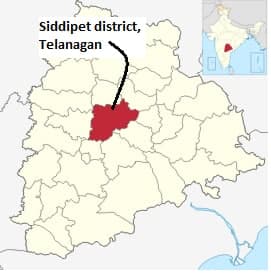
- Gram panchayat and covid-19
- During the first and second waves of Covid-19, panchayats played a vital role in containing the spread of virus among rural population, despite the reverse migration from cities. With 65% ofthe country's population residing in rural areas, their role was indispensable in managing the widespread catastrophe.
- Through Jan Bhagidari and effective local governance, they have been working at the forefront in providing necessary health facilities and ensuring timely vaccinations.
- The pandemic has highlighted how improving functions of PRIs for better delivery of services is essential for the well-being of rural population, which aids rest of the country dependent upon them for basic amenities. Panchayats have a significant role to play in the effective and efficient implementation of flagship schemes on subjects of national importance. There are many reforms such as the recently-launched SVAMITVA Scheme for land ownership, which are adding to financial benefits and better management of resources.
However, the functioning of the Gram Sabhas has not been smooth and they have come under criticism due to a lack of regularity and transparency. Issues such as low participation, irregular Gram Sabha meetings, absence of a coherent Gram Sabha agenda, etc., have been some of the major hurdles in their effective functioning. In various instances, it is seen that the vulnerable sections of the village community hesitate to voice opinions due to inhibitions on account of their financial and social standing. This reduces Gram Sabhas to mere symbolic, instead of functional and vibrant platforms of democratic local governance.
Potential and Advantages of Biofuels in India
Why in news: India is on track to surpass China as the world’s third-largest ethanol consumer by 2026.

Potential of biofuels in India:

- Local-resource based: A wide range of local materials such as agricultural waste, forestry residues, livestock waste etc. can be mobilized as source materials for the production of biofuels.
- India generates about 350 million tonnes of agricultural waste every year. As per the estimates given by the ministry of new and renewable energy, this can be converted into biofuels such as ethanol and biodiesel & can generate more than 18,000 MW of power every year apart from generating green fertilizer for use in agriculture.
- India produces about 3 million tons of dung annually with its 512 Million of livestock population. This livestock can be used as a feedstock for the production of biofuels.
- Municipal Solid Waste (MSW) management: It is estimated that, annually 62 MMT of Municipal Solid Waste gets generated in India. There are technologies available which can convert waste/plastic, MSW to drop in fuels. One ton of such waste has the potential to provide around 20% of drop in fuels.
Advantages of biofuels in India
- Additional Income to Farmers: By adopting 2G technologies, agricultural residues/waste which otherwise are burnt by the farmers can be converted to ethanol and can fetch a price for these waste if a market is developed for the same. Also, farmers are at a risk of not getting appropriate price for their produce during the surplus production phase. Thus conversion of surplus grains and agricultural biomass can help in price stabilization.
- GHG Emissions reduction: One crore lit of E-10 saves around 20,000 ton of CO2 emissions. Biofuels can reduce the consumption of fossil fuels and thus reduce carbon dioxide emissions, because biofuels are carbon neutral. Also by reducing crop burning & conversion of agricultural residues/wastes to biofuels there will be further reduction in Green House Gas emissions.
- Energy security: Biofuels help to enhance and safeguard energy security by reducing the reliance on fossil energy sources and diversifying our energy basket with more renewable mix (currently 12.83% of the total renewable energy generation is contributed by biofuels alone) & as biofuels can be produced locally, which decreases the nation's dependence upon foreign energy.
- Regional development: Establishment of biofuel refineries will lead to infrastructural investment in rural areas and has huge prospects for employment generation. This will contribute to regional development while adhering to the maintenance of ecological balance, as adoption of biofuels lead to emissions reduction and promotion of circular bio-economy. This is in line with the regional development principle of ecological equilibrium.
- Health benefits: Prolonged reuse of Cooking Oil for preparing food, particularly in deep-frying is a potential health hazard and can lead to many diseases. Used Cooking Oil is a potential feedstock for biodiesel and its use for making biodiesel will prevent diversion of used cooking oil in the food industry.
Several challenges and concerns associated with biofuel production in India:
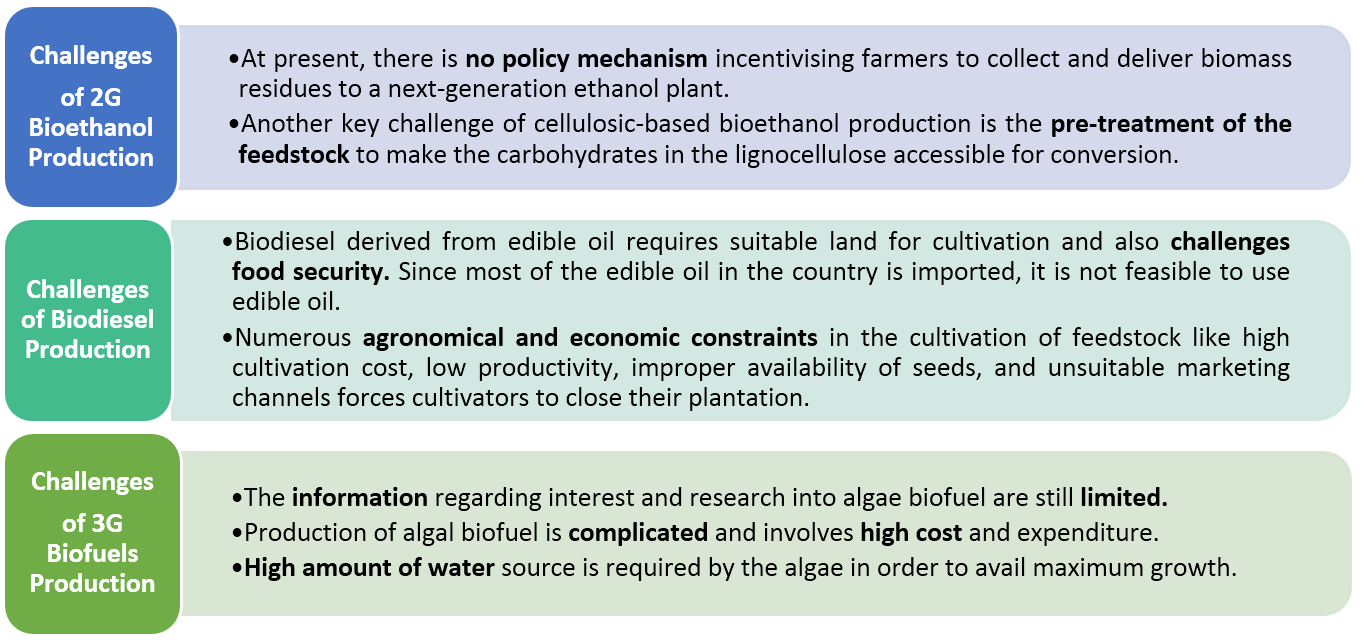

Where it can be used?
It can be used in topics related to Paper 1 (Climate Change, Sustainable development, Energy crisis, Food security) and Paper 2 (Energy crisis, Agriculture, Regional development and planning) and GS 3 (Energy, Agriculture).
Sources:
Jal Jeevan Mission
- Why in news: In Jharkhand, drinking water supply schemes totalling 9,544 crore have been approved under the Jal Jeevan Mission (JJM).
- Objective: It was lunched by the central government in 2019, with an objective to provide safe and adequate drinking water through Functional Household Tap Connections (FHTC) by 2024 to all households in rural India.
- JJM looks to create a jan andolan for water, thereby making it everyone’s priority.
- Funding pattern: The fund sharing pattern between the Centre and states is 90:10 for Himalayan and North-Eastern States, 50:50 for other states, and 100% for Union Territories.
- Institutional arrangement: For the implementation of JJM, following institutional arrangement has been proposed: National Jal Jeevan Mission (NJJM) at the Central level, State Water and Sanitation Mission (SWSM) at the State level, District Water and Sanitation Mission (DWSM) at the District level and Village Water Sanitation Committee (VWSC) at Village level. Every village will prepare a Village Action Plan (VAP) which will have three components: Water source & its maintenance, Water supply and Greywater (domestic wastewater) management.
- Key components: JJM is based on a community approach to water and includes extensive Information, Education and Communication as a key component of the mission. Creation of local infrastructure for source sustainability measures as mandatory elements, like rainwater harvesting, groundwater recharge and management of household wastewater for reuse, would be undertaken in convergence with other government programmes/schemes.
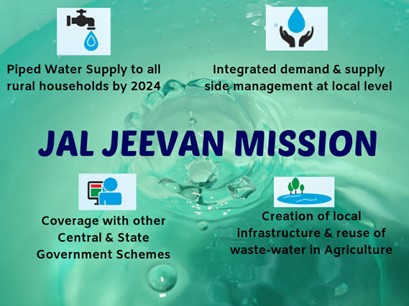
Source:
Zero budget natural farming (ZBNF)
It is a set of farming methods, and also a grassroots peasant movement, to promote chemical-free agricultural practices, drawing from traditional Indian practices.
It was originally promoted by Maharashtrian agriculturist Subhash Palekar, who developed it in the mid-1990s as an alternative to the Green Revolution’s methods driven by chemical fertilizers and pesticides and intensive irrigation. Through ZBNF, the cost of production could be reduced and farming made into a “zero budget” exercise, breaking the debt cycle for many small farmers.
- Components of ZBNF:
- The ZBNF promotes the application of jeevamrutha — a mixture of fresh desi cow dung and aged desi cow urine, jaggery, pulse flour, water and soil — on farmland. This is a fermented microbial culture that adds nutrients to the soil, and acts as a catalytic agent to promote the activity of microorganisms and earthworms in the soil.
- A similar mixture, called bijamrita, is used to treat seeds, while concoctions using neem leaves and pulp, tobacco and green chillis are prepared for insect and pest management.
The ZBNF method also promotes soil aeration, minimal watering, intercropping, bunds and topsoil mulching and discourages intensive irrigation and deep ploughing.

- ZBNF and Organic Farming
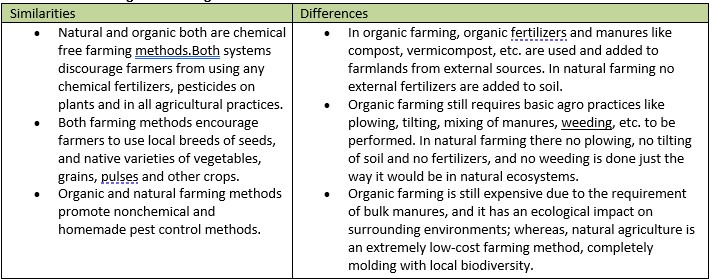
ZBNF is against vermicomposting, which is the mainstay of typical organic farming, as it introduces the the most common composting worm, the European red wiggler (Eisenia fetida) to Indian soils. These worms absorb toxic metals and poison groundwater and soil.
National Digital Health Mission
Why in News? - The Prime Minister of India announced the launch of National Digital Health Mission (NDHM) on Independence Day in 2021.
NDHM - The mission aims to create an integrated healthcare system linking practitioners with the patients digitally by giving them access to real-time health records. This will promote prompt and structured healthcare across the country.
DHM will create a seamless online platform through the provision of a wide-range of data, information and infrastructure services, duly leveraging open, interoperable, standards-based digital systems while ensuring the security, confidentiality and privacy of health-related personal information.
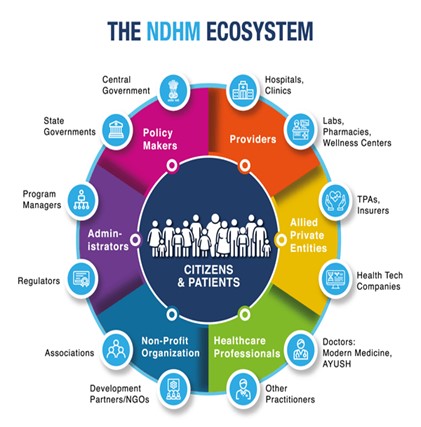
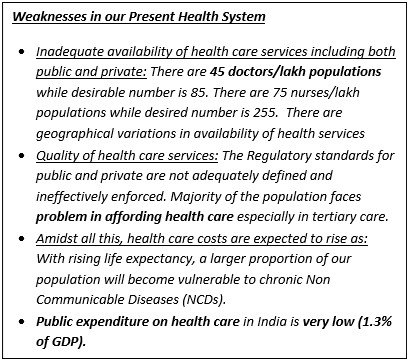
Pros and cons of DHM –
- Like any public good, it would have positive and negative externalities. The positive externalities are substantial — improving India’s health outcomes, especially for the poor, through accelerating increased participation in the healthcare system through efficient information sharing.
- The negative externalities include data misuse, leakages, profiteering, and foreign surveillance and so on leading to high socio-economic costs.
Source:
Temporary flood water storage in agricultural areas in the Middle Tisza river basin – Hungary
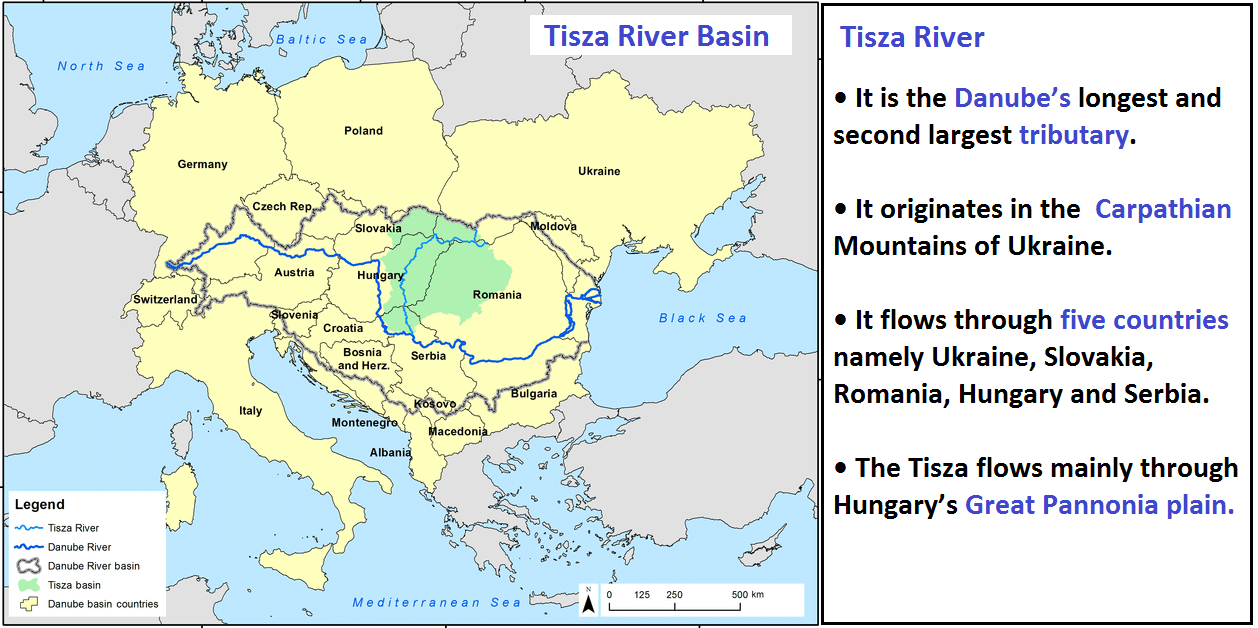
Hungary’s flood challenges in the middle Tisza River basin:
- Increased flood risk: There was an increased flood risk in the river basin due to changes in precipitation patterns due to climate change, deforestation and soil sealing.
- River regulation: In the second half of the 19th century, the river and its tributaries were regulated to increase the extent of agricultural land, in place of wetlands, marshes and areas at risk of regular flooding. The length of the river was reduced by over 400 km as the meandering sections were cut through, while the size of the floodplain area decreased by over 90% as dikes were raised to protect against floods. As a consequence, peak flood water levels increased.
Measures taken by Hungary to minimize the flood risk in the Tisza River basin:
- In the year 2000, the government started strengthening the river dikes. In 2004, the government decided to increase flood safety by the reactivation of former floodplain However, these measures were not much successful in minimizing the flood risk.
- In 2007, the government called for using agricultural areas as temporary storage reservoir for containing peak flow during extreme events. The area is utilized for agricultural purposes in normal period, but could be eventually flooded and utilized for temporary retention of flood waters in case of emergency.
- Benefits associated with this measure: This allows buffering during extreme precipitation events and reducing flood wave propagation, with consistent beneficial implications in terms of flood risk mitigation.
- Concerns associated with this measure: From an engineering perspective the strategy proved to be successful, but some loose ends remain with respect to flood induced agricultural damages within the reservoirs.
Where it can be used?
It can be used in topics related to Paper 1 (Climate Change, Problems of Urbanization), Paper 2 (Floods, Problems of urbanization, Deforestation) and GS 1 (Urbanization)
Source:
Places in news
|
Mazgaon
|
|
Subansiri River
|
|
Orang National Park
|
|
Pangong Tso Lake
|
|
Keoladeo National Park
|
|
Mundra Port
|
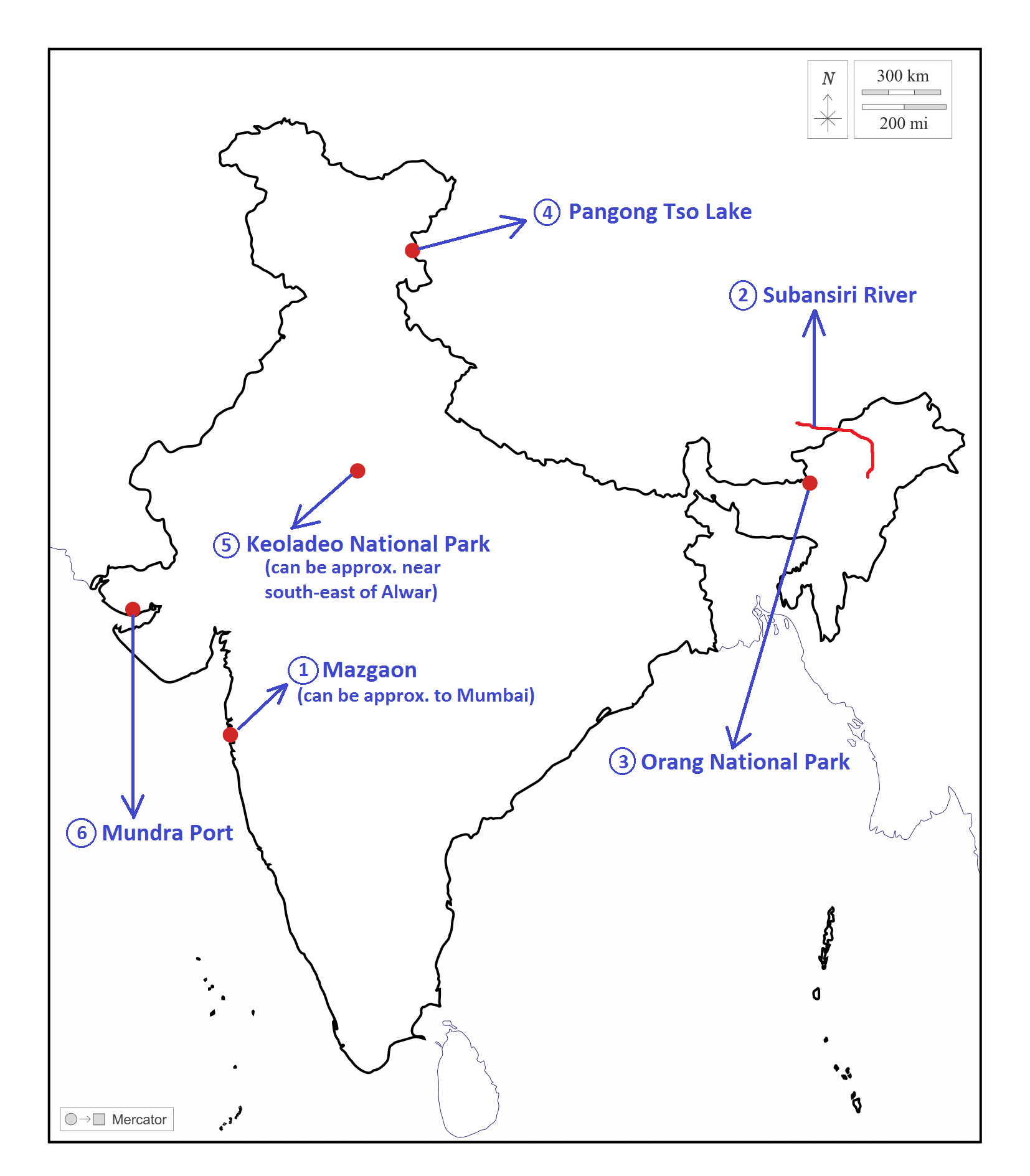
Share the article
Get Latest Updates on Offers, Event dates, and free Mentorship sessions.

Get in touch with our Expert Academic Counsellors 👋
FAQs
Geography Current Affairs focuses on the contemporary issues, events, and developments in the field of geography. It covers recent geographical phenomena, environmental changes, geopolitical shifts, and related news. This differs from regular geography studies which may focus more on foundational concepts, historical contexts, and theoretical frameworks.
Updates are provided regularly to ensure that subscribers stay informed about the latest developments in geography. Typically, updates are provided on a fortnightly basis, depending on the frequency of significant events and changes in the field.
Absolutely. Geography Current Affairs serves as a valuable resource not only for Geography optional but also for GS papers, especially GS Paper 1 (covering Indian Heritage and Culture, History, and Geography of the World and Society) and GS Paper 3 (covering Technology, Economic Development, Biodiversity, Environment, Security, and Disaster Management). It aids in building a holistic understanding of various topics and strengthens answer-writing skills by incorporating contemporary examples and perspectives.
Geography Current Affairs holds immense importance for UPSC preparation, particularly for aspirants opting for Geography optional. It helps candidates stay updated with the latest developments, geographical phenomena, environmental issues, and geopolitical shifts worldwide, aligning them with the dynamic nature of the subject as tested in the UPSC examinations.

